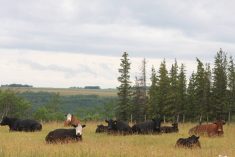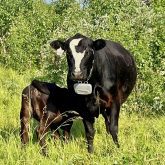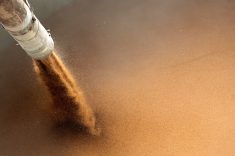It’s a routine summer day of checking cattle, maybe repairing a bit of fence. Nothing too stressful, at least until you see the dugout you’re using as a water source for your cattle, which has algae in it.
Now what?
The first question is whether it’s blue-green algae, which can release toxins harmful to cattle, or something more benign.
To do so, find a stick, or put on a pair of gloves (don’t use your bare hands), and lift some algae from the water. “If you can lift it up, and it’s a long, stringy mass, those are the filamented-type algae. They’re not toxic,” says Jenifer Heyden, a livestock and feed extension specialist with Saskatchewan Agriculture, based out of North Battleford.
Blue-green algae is actually a bacteria, known as cyanobacteria. When you lift it, it won’t be a stringy mass, Heyden says. “It’s probably going to slide off your hand. Or you’ll just have little, tiny bits that are left on your hand.”
If you’re seeing tiny lily pads, with little white roots, you’re looking at duck weed. Although some may consider it unsightly, it’s benign. “Duck weed usually will signify that you have a pretty good quality water.”
Heyden says producers can also take a photo and send it to a local extension person or expert, if they’re not sure what they’re looking at.
Probably the safest option, if you do see blue-green algae, is to collect a sample (about 100 ml), freeze it and send it to Prairie Diagnostic Services for an analysis. That’s because while you can see the algae, you have no way of knowing whether or not the toxins are actually present, Heyden explains. There may be a lot of algae, but that doesn’t mean it has released any toxins.
“On the same note, maybe it doesn’t look like a significant bloom, but you can still have that toxin there.”
Heyden suggests collecting the sample based on where the cattle are drinking. Don’t collect water right at the edge, but don’t reach into the middle of the dugout for the sample either, as the cattle aren’t drinking there. Also, remember that the farther down in the water column you go, the less blue-green algae you’ll likely find.
If you have the misfortune to lose animals, Prairie Diagnostic Services recommends collecting samples within 24 hours of the deaths, as the toxins can disappear quickly from the water.
There are rapid tests available for blue-green algae, but Heyden doesn’t recommend them for testing livestock water. They’re more commonly used for checking water before allowing people or pets to swim, she explains, and lack the sensitivity needed for livestock water. That lack of sensitivity means you’re more likely to end up with false negatives or false positives. Typically, such tests don’t detect all the toxins that may be present, or tell you how much toxin is present, either. Prairie Diagnostic Services, at the University of Saskatchewan, has a quick turn-around and will test for both types of toxins, Heyden says. Saskatchewan producers can contact their regional offices to have samples shipped, but producers can also contact Prairie Diagnostic Services directly.
One toxin you may encounter is a microcystin, which affects the liver. You also might see it referred to as a hepatotoxin. For cattle, the danger zone for microcystins starts at 4.2 micrograms (μg) per litre, but sheep and horses are less tolerant. Liver toxins typically cause problems such as photosensitivity, especially in animals with light-coloured faces or muzzles.
“But blue-green algae can also have anatoxin associated with it, which is the neurotoxin.” Heyden couldn’t find a “safe” level for the anatoxin, but she suspects it’s lower than the hepatotoxin.
“The neurotoxin is going to be a lot quicker, and it’s probably more likely that your deaths are caused by that neurotoxin, as opposed to the hepatotoxin.”
Whatever the toxin levels, keep in mind that a test is a “snapshot in time. It may not still be at that level once you get the test back.”
Blue-green algae conditions can change quickly. “It might be there, and not blooming today, but you can have a bloom tomorrow.”
Risk factors include nitrate and phosphate levels in the water, as high phosphate levels favour algae. Low nitrogen-phosphate ratios also favour algae, Prairie Diagnostic Services notes. Weather is also part of the mix. “Temperature’s the big one, and especially if there’s a rapid change in temperature,” says Heyden.
For example, four or five really hot days, followed by a cool, cloudy day creates stress, and can cause a bloom or toxin release, Heyden explains.
Heyden recommends monitoring the water if you’ve got blue-green algae, even if the test results don’t show dangerous toxin levels. If you can move the cattle out for two to three weeks and treat the water, that’s a good option. Or avoid using the water source for a while, and test again a few days before you want to use it.
There are preventative products — basically blue dyes that darken the water so less sunlight penetrates it, reducing the risk of blue-green algae. Prairie Diagnostic Services also suggests shading the water if possible.
Ag retailers also have copper-sulphate (bluestone) products to treat water. “The key is to follow the recommendations. More is not necessarily better.”
Prairie Diagnostic Services can be contacted online. Sask Ag also has a list of water and feed testing labs from across the country.
















